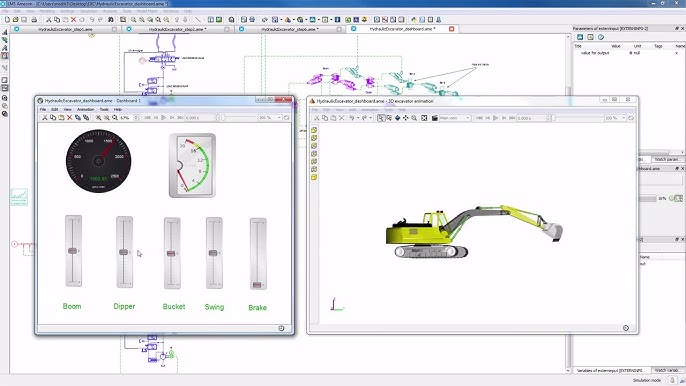Mastering Transient Analysis in Simcenter Amesim: A Comprehensive Guide

Introduction: Transient analysis is a fundamental aspect of dynamic system simulation, providing insights into the time-varying behavior, response, and performance of complex engineering systems. Simcenter Amesim is a leading multi-domain simulation software widely used for modeling and analyzing dynamic systems in various industries, including automotive, aerospace, energy, and industrial automation. In this comprehensive guide, we will delve into the process of performing transient analysis in Simcenter Amesim, covering key concepts, modeling techniques, simulation methods, and best practices to help engineers master the art of dynamic system simulation.
Section 1: Understanding Transient Analysis
1.1 Importance of Transient Analysis: Transient analysis is essential for studying the dynamic behavior and response of engineering systems to transient events, disturbances, and inputs over time. It allows engineers to assess system dynamics, stability, transient phenomena, and time-dependent performance characteristics, such as start-up, shutdown, transient response, and dynamic load variations. Transient analysis enables engineers to optimize system design, control strategies, and operational performance to meet desired specifications and requirements.
1.2 Key Concepts in Transient Analysis:
- Time-domain simulation: Transient analysis involves simulating system behavior in the time domain, tracking changes in system variables, states, and responses over time.
- Initial conditions: Transient analysis considers the initial conditions of the system, including initial states, positions, velocities, and environmental conditions, which influence system behavior during transient events.
- Dynamic response: Transient analysis evaluates the dynamic response of systems to time-varying inputs, disturbances, or boundary conditions, capturing transient effects, oscillations, and transient stability.
- Time step: Transient analysis uses a time-stepping approach to advance simulation time incrementally, solving dynamic equations iteratively at each time step to update system states and responses.
Section 2: Modeling Dynamic Systems in Simcenter Amesim
2.1 System Modeling Approach: Begin by defining the system topology, components, connections, and interactions using Simcenter Amesim’s graphical modeling environment. Select appropriate component libraries, such as hydraulic, pneumatic, mechanical, electrical, thermal, or control system components, to represent system elements and dynamics accurately.
2.2 Component Modeling and Parameterization: Model individual system components, such as actuators, sensors, valves, pumps, motors, controllers, and energy storage devices, using predefined component models or customized models based on physical principles, empirical data, or mathematical equations. Parameterize component models with relevant properties, parameters, characteristics, and operating conditions to capture system behavior accurately.
2.3 System Integration and Interactions: Integrate system components, subsystems, and interactions within Simcenter Amesim’s modeling environment, defining connections, interfaces, signals, and feedback loops to represent system coupling, feedback control, and dynamic interactions. Ensure consistency, compatibility, and connectivity between system elements to enable accurate transient analysis and simulation.
2.4 Boundary Conditions and Inputs: Specify boundary conditions, initial conditions, and time-varying inputs, such as external forces, commands, setpoints, or disturbances, to drive system behavior and simulate transient events. Define input profiles, waveforms, ramps, steps, or user-defined functions to represent realistic operating scenarios and dynamic load variations.
Section 3: Performing Transient Analysis in Simcenter Amesim
3.1 Simulation Setup and Configuration: Configure simulation settings, solver options, time discretization parameters, and numerical algorithms within Simcenter Amesim’s simulation environment. Define simulation duration, time step size, convergence criteria, and output intervals to control simulation accuracy, stability, and computational efficiency.
3.2 Time-Domain Simulation: Perform time-domain simulation in Simcenter Amesim to simulate system behavior and responses over a specified time horizon. Use implicit or explicit numerical integration methods, such as Euler, Runge-Kutta, or Gear methods, to solve dynamic equations and update system states iteratively at each time step.
3.3 Transient Response Analysis: Analyze transient response characteristics, such as time-domain waveforms, trajectories, transient phenomena, and dynamic performance metrics, using Simcenter Amesim’s post-processing tools and visualization capabilities. Plot system variables, states, and responses over time to analyze transient behavior, identify critical events, and evaluate system performance.
3.4 Sensitivity Analysis and Parameter Studies: Conduct sensitivity analysis, parametric studies, or design exploration studies to assess the impact of model parameters, uncertainties, or design variables on system behavior and transient response. Explore design alternatives, optimization strategies, and sensitivity trends to improve system performance, robustness, and reliability.
Section 4: Best Practices for Transient Analysis in Simcenter Amesim
4.1 Model Simplification and Abstraction: Simplify complex system models by abstracting detailed components, subsystems, or phenomena to focus on essential dynamics and interactions relevant to transient analysis objectives. Use lumped-parameter models, reduced-order models, or simplified representations to streamline model complexity while preserving critical dynamic behavior.
4.2 Model Validation and Verification: Validate and verify Simcenter Amesim models against experimental data, analytical solutions, or benchmark simulations to ensure model accuracy, reliability, and predictive capability for transient analysis. Compare simulation results with empirical measurements, theoretical predictions, or industry standards to assess model fidelity and credibility.
4.3 Sensitivity to Initial Conditions and Inputs: Assess sensitivity of system behavior to initial conditions, boundary conditions, and input parameters by performing sensitivity analysis or uncertainty quantification studies in Simcenter Amesim. Evaluate transient response variability, robustness, and stability under different starting conditions, perturbations, or input variations to understand system sensitivities and potential failure modes.
4.4 Convergence and Numerical Stability: Monitor simulation convergence, numerical stability, and solution accuracy during transient analysis in Simcenter Amesim to ensure reliable and robust simulation results. Adjust solver settings, time step sizes, or convergence criteria to mitigate numerical instabilities, oscillations, or divergence issues and improve simulation performance and reliability.
Conclusion: Performing transient analysis in Simcenter Amesim enables engineers to gain insights into the dynamic behavior, transient response, and performance of complex engineering systems under time-varying conditions. By following best practices, modeling techniques, and simulation methodologies outlined in this guide, engineers can leverage Simcenter Amesim’s capabilities to design, analyze, and optimize dynamic systems effectively. Transient analysis in Simcenter Amesim empowers engineers to address transient phenomena, assess system dynamics, and enhance system performance across various industries and applications, driving innovation, efficiency, and reliability in engineering design and development.





